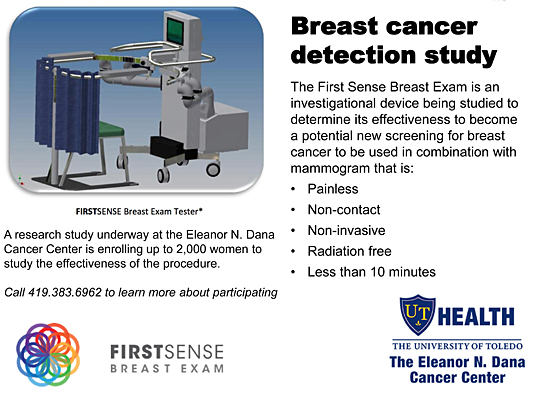An investigational technology is being studied to determine if it can assist in early breast cancer detection. This investigational technology that is being studied at The University of Toledo Medical Center uses thermal imaging to see if it can identify tumors. The radiation-free and painless test uses cool air and a camera to measure the temperature of the skin surface.
Throughout 2016, patients visiting the Eleanor N. Dana Cancer Center for a mammogram will be offered the opportunity to participate in the First Sense Medical research study to evaluate the effectiveness of the investigational First Sense Breast Exam® procedure. The goal is to enroll up to 2,000 women who are 18 years of age or older in order to compare the results of both tests to determine the potential for the thermal scan to be used as an additional breast cancer detection tool.
 “The mammogram has long been used as the standard of care in screening for breast cancer and, through this clinical trial, we are evaluating the First Sense Breast Exam as an adjunctive screening device for the detection of breast cancer that is radiation-free and pain-free with no breast compression or any physical contact with the patient. In this study, the First Sense Breast Exam is performed immediately prior to the mammogram in the same clinic visit,” said Dr. Haitham Elsamaloty, a UT radiologist and professor of radiology, who is the principal investigator for the study.
“The mammogram has long been used as the standard of care in screening for breast cancer and, through this clinical trial, we are evaluating the First Sense Breast Exam as an adjunctive screening device for the detection of breast cancer that is radiation-free and pain-free with no breast compression or any physical contact with the patient. In this study, the First Sense Breast Exam is performed immediately prior to the mammogram in the same clinic visit,” said Dr. Haitham Elsamaloty, a UT radiologist and professor of radiology, who is the principal investigator for the study.
The First Sense Breast Exam procedure takes less than 10 minutes. The patient disrobes from the waist up and sits on a chair in front of the machine’s infrared and 3D cameras. Thermal images are then taken from the front and sides of the breasts both before and after cool air is blown on the patient.
The patient is exposed to a cool air to cause normal blood vessels to contract and reduce the temperature of normal tissue, but the blood vessels that feed the tumor do not contract so the temperature of the tumor does not change. The infrared thermal imaging camera measures the difference in skin surface temperature to identify abnormalities.
“The thermal imaging screening could be particularly helpful for younger patients and women with dense breast tissue for which it is more difficult to detect tumors using mammography,” Elsamaloty said.